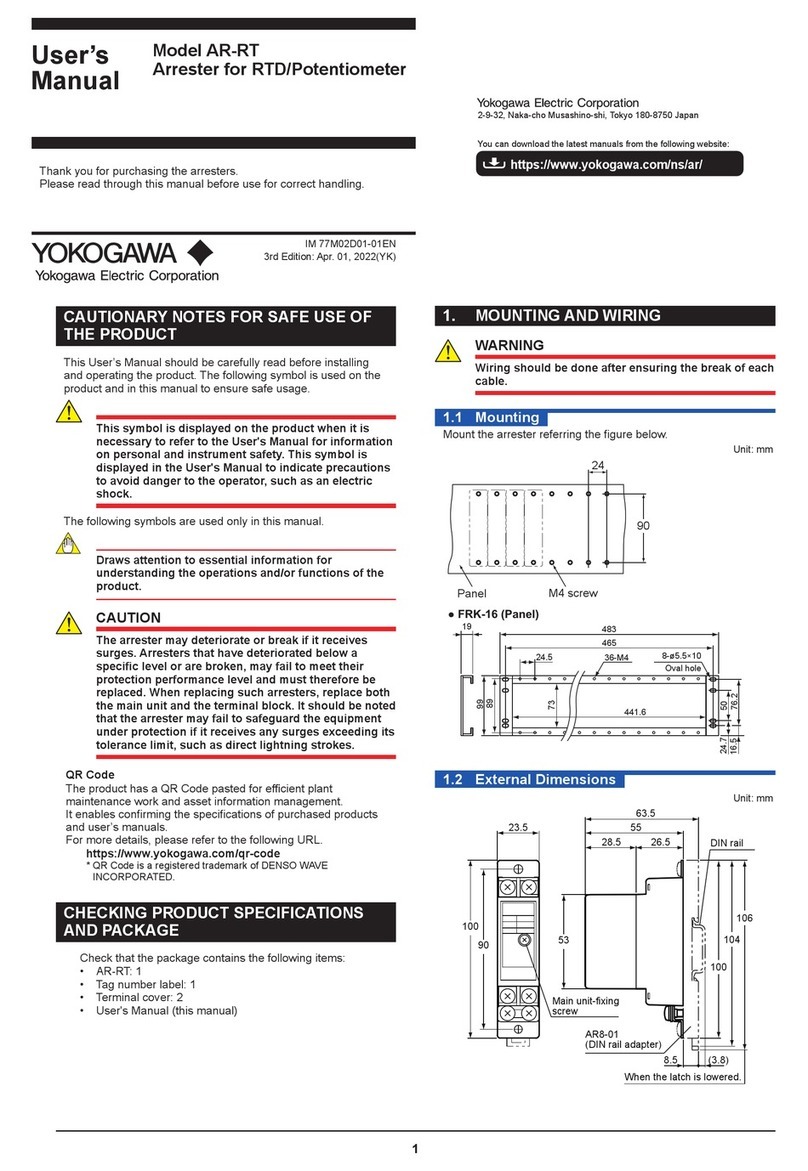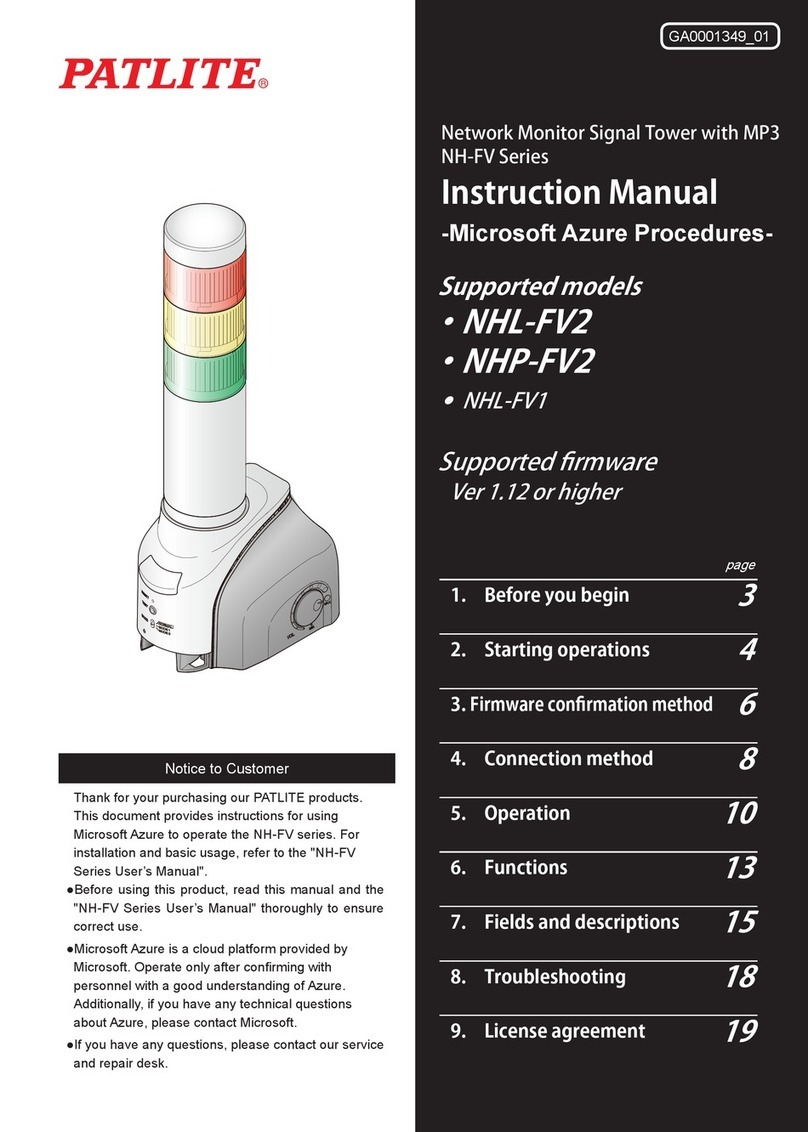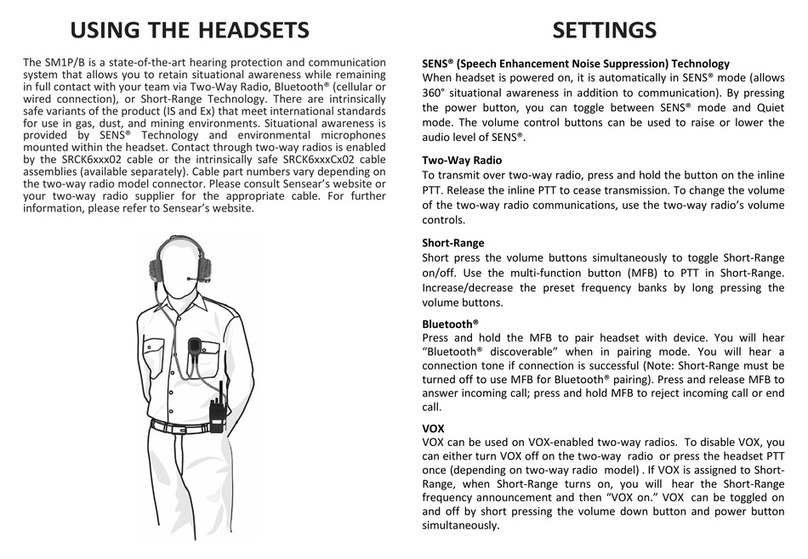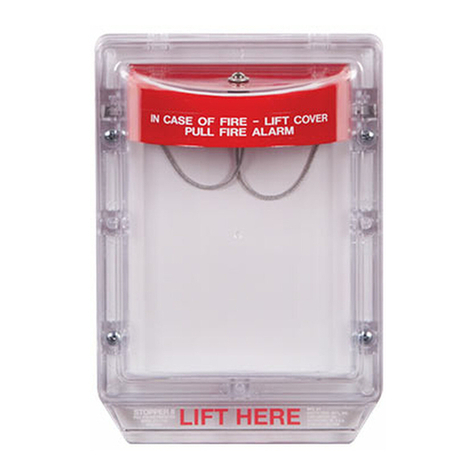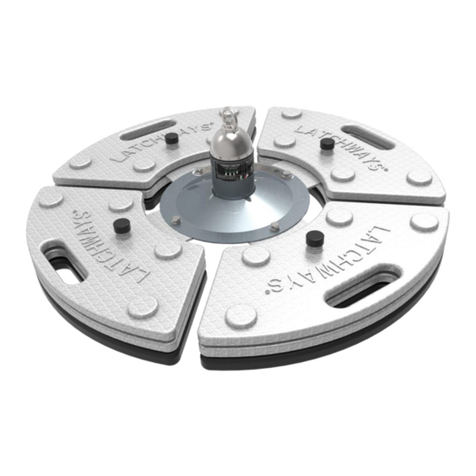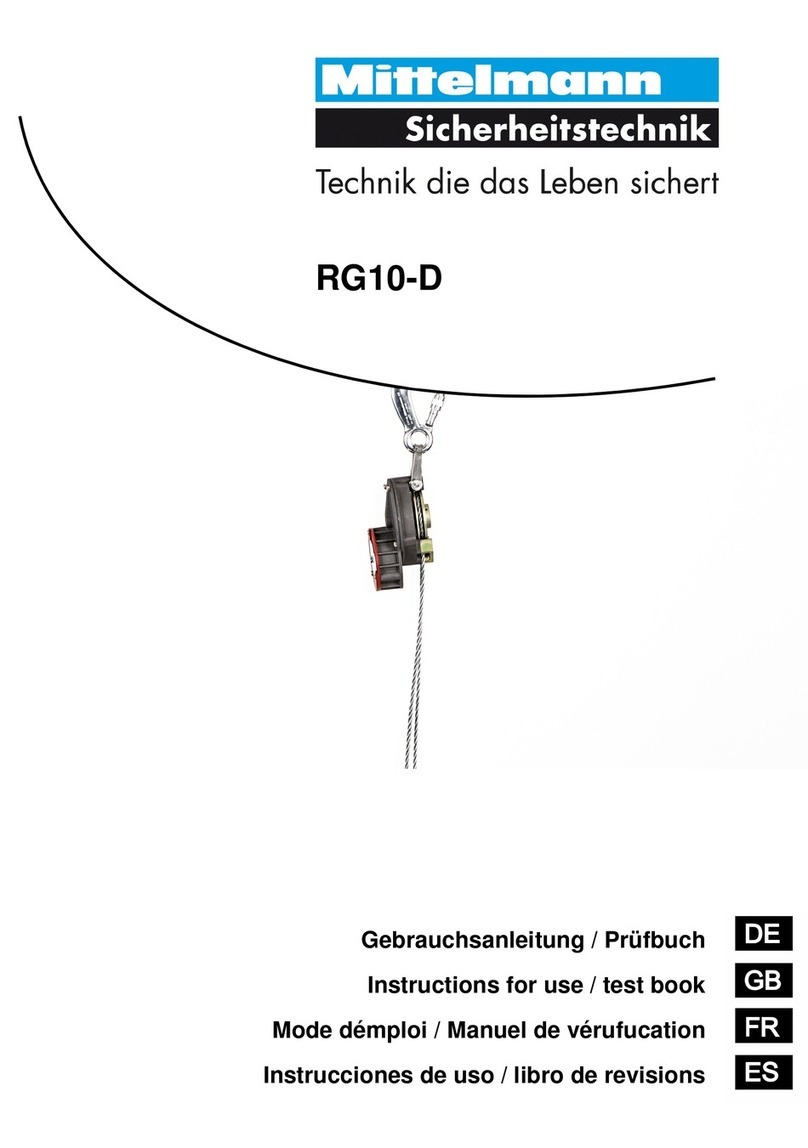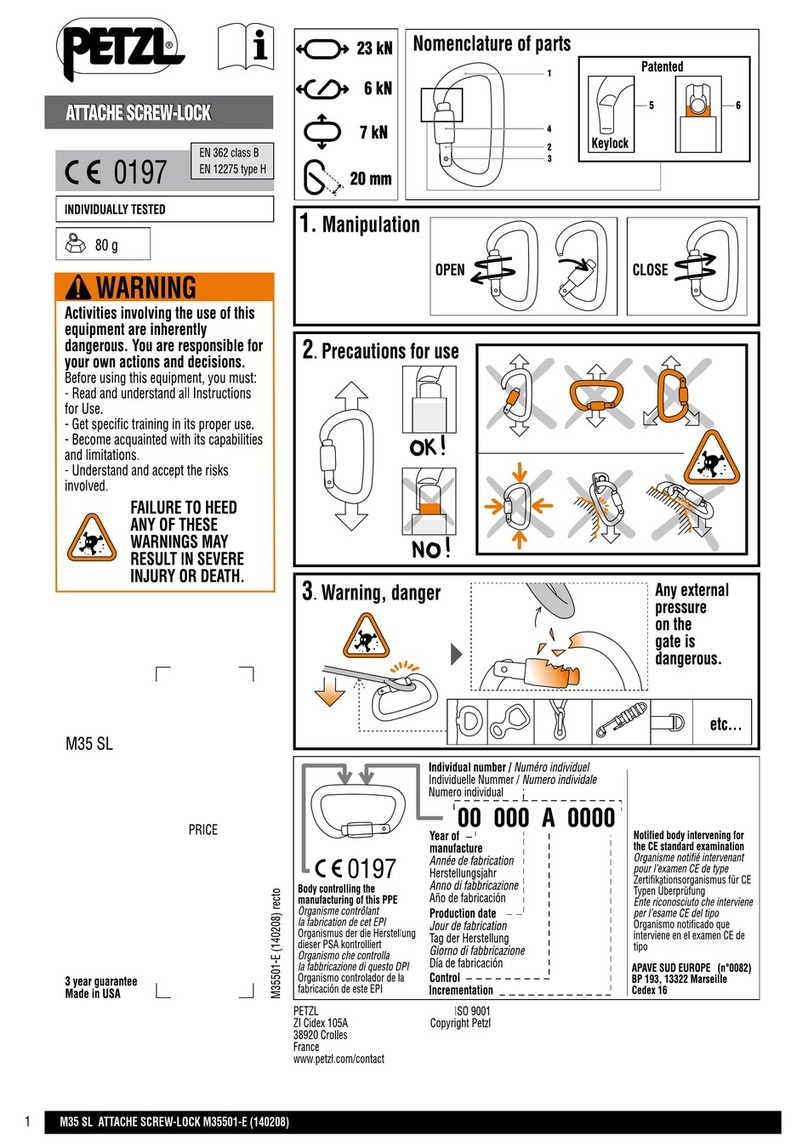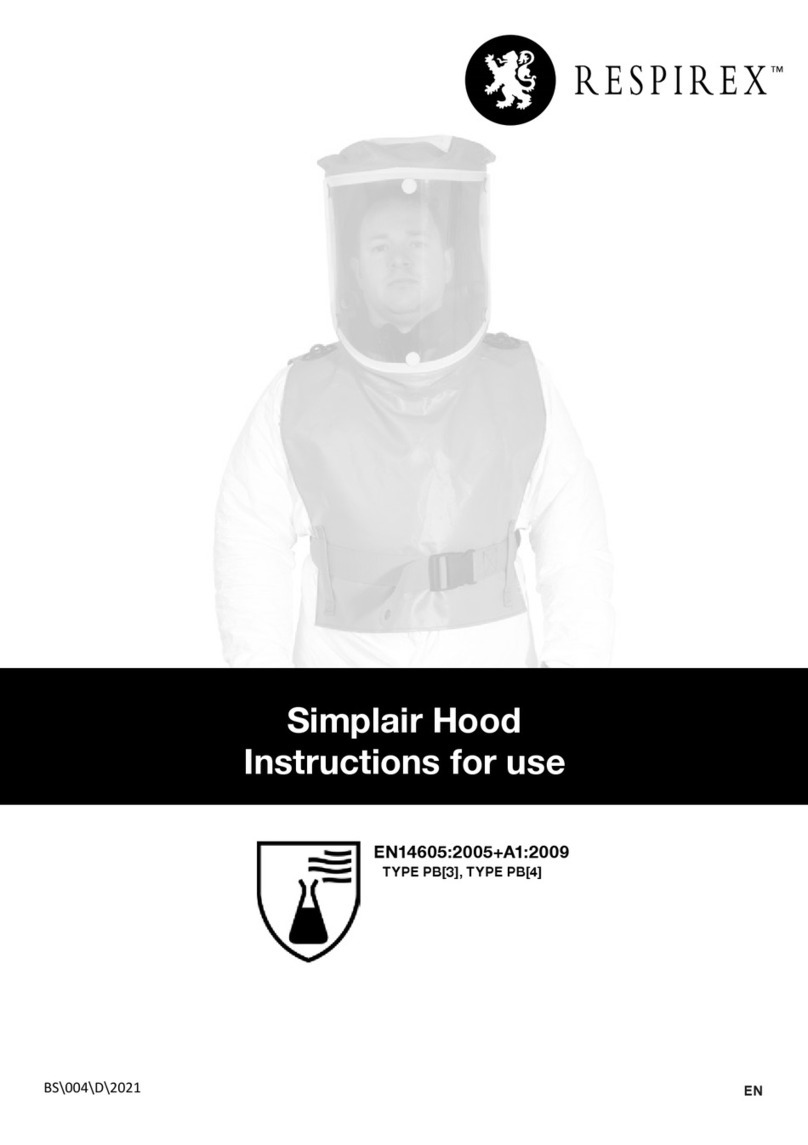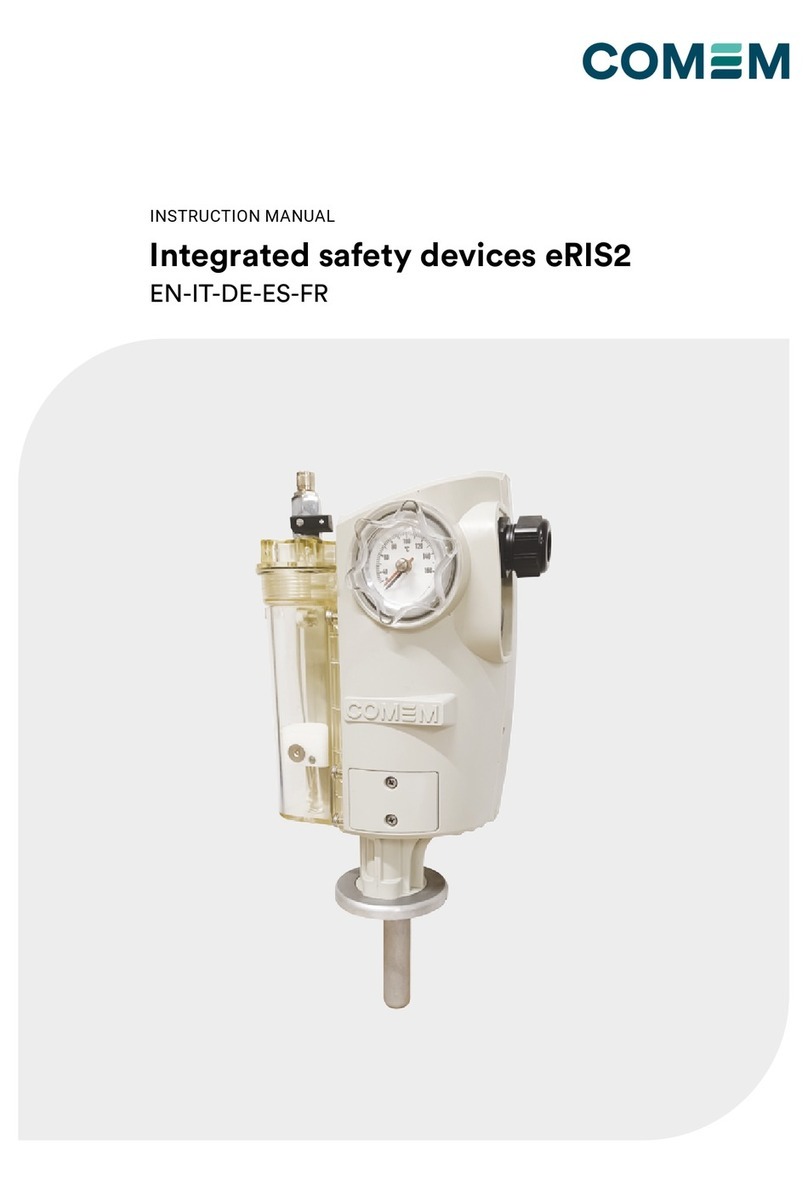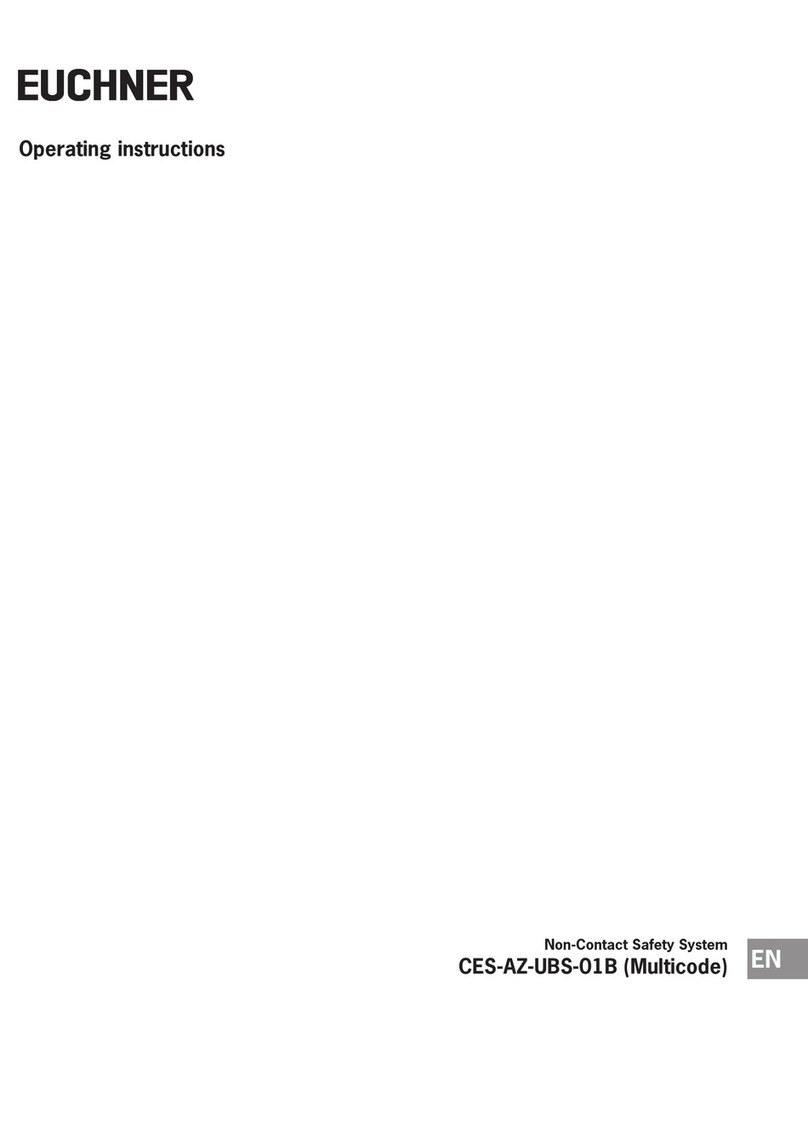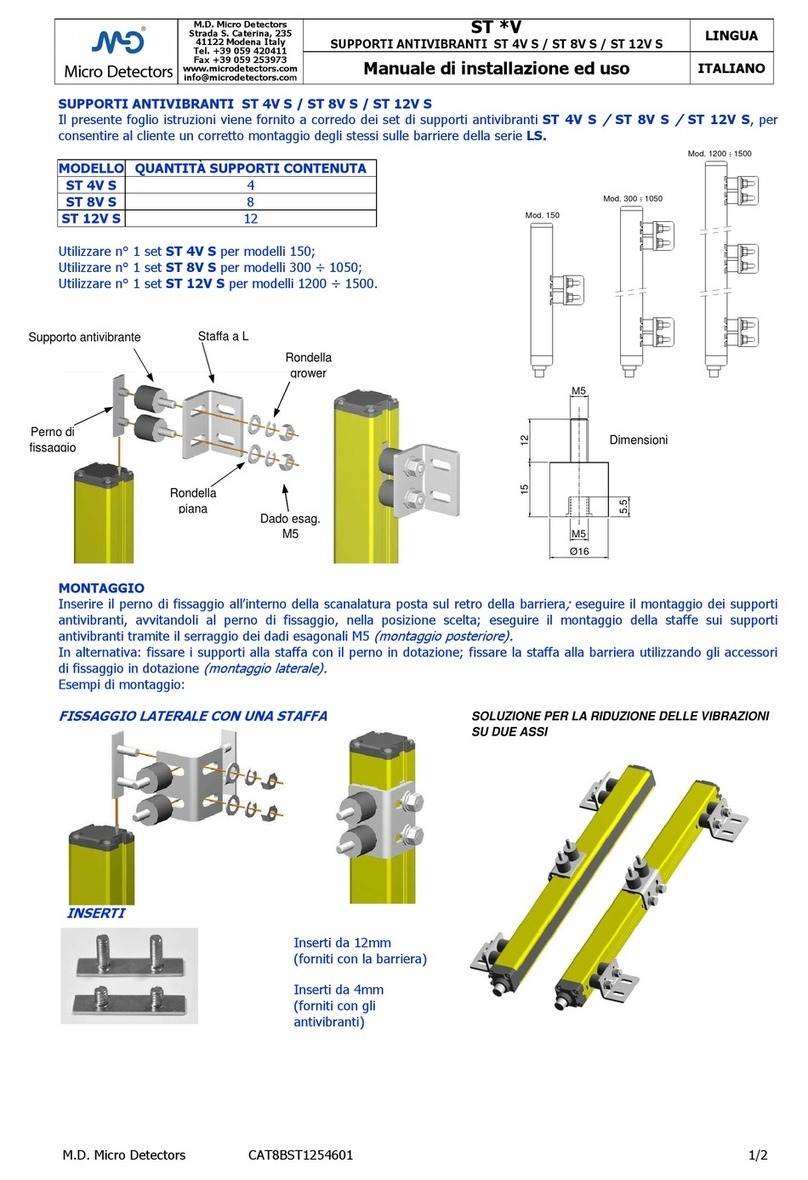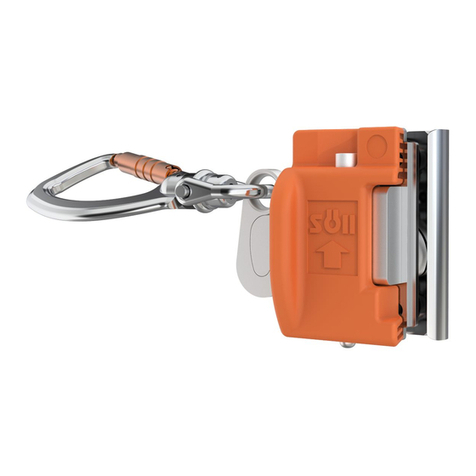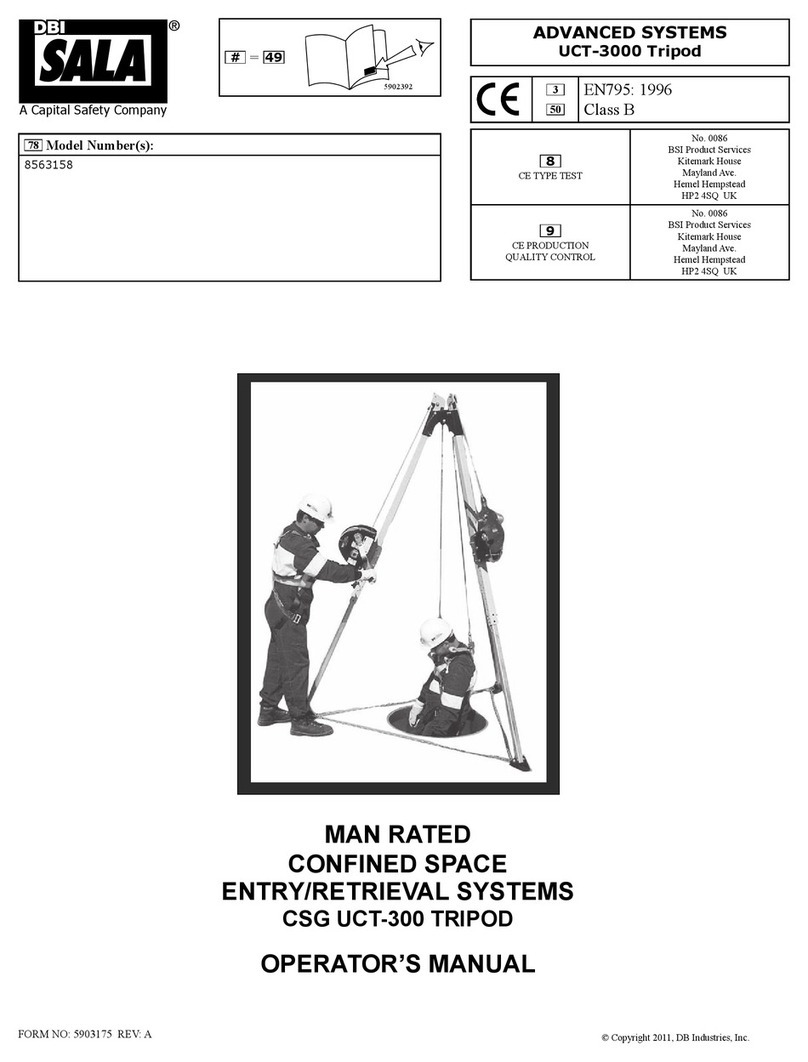YOKOGAWA ProSafe-COM Manual

Technical
Information System Overview
ProSafe-COM 3.00 ProSafe-COM
TI48J01A00-00E-N
Yokogawa Europe Solutions B.V.
PO Box 163, 3800 AD, Amersfoort, The Netherlands
Tel: (31) 88-464 1000 Fax: (31) 88-464 1111
TI48J01A00-00E-N
©Copyright 2010
4th Edition Oct 2010

System Overview ProSafe-COM 3.00 2 of 49
TABLE OF CONTENTS
Preface .......................................................................................................................................................... 4
About this manual.......................................................................................................................................... 5
1An introduction to ProSafe-COM............................................................................................................ 7
1.1 ProSafe-COM and the ProSafe family............................................................................................ 7
1.2 MODCOM / MULCOM versus ProSafe-COM................................................................................. 9
1.3 ProSafe-COM context................................................................................................................... 10
1.4 ProSafe-COM and CENTUM........................................................................................................ 13
1.5 Functions overview ....................................................................................................................... 14
1.6 Hardware overview ....................................................................................................................... 15
1.7 Interface overview......................................................................................................................... 16
2ProSafe-COM functions ....................................................................................................................... 18
2.1 Basic function................................................................................................................................18
2.2 Status acquisition.......................................................................................................................... 19
2.3 Sequence of events recording...................................................................................................... 20
2.4 Forcing statuses............................................................................................................................ 20
2.5 Configuring ProSafe-COM............................................................................................................ 21
3ProSafe-COM hardware....................................................................................................................... 25
3.1 Hardware concept......................................................................................................................... 25
3.2 19 inch housing with modules....................................................................................................... 25
3.3 Main board .................................................................................................................................... 26
3.4 V-net interface board..................................................................................................................... 26
3.5 M-BUS/M-NET interface board..................................................................................................... 26
3.6 Ethernet interfaces........................................................................................................................ 26
3.7 Serial interface board.................................................................................................................... 26
3.8 Y-net interface board..................................................................................................................... 26
3.9 ProSafe-COM and ProSafe safety system modules..................................................................... 27
4ProSafe-COM interfaces...................................................................................................................... 30
4.1 Access to status map and event list.............................................................................................. 30
4.2 Printer............................................................................................................................................ 31
4.3 User interface................................................................................................................................31
4.4 V-net interface............................................................................................................................... 31
4.5 M-BUS/M-NET interface ............................................................................................................... 32
4.6 Ethernet interface.......................................................................................................................... 32
4.7 Serial interfaces ............................................................................................................................ 33
4.8 Y-net interface............................................................................................................................... 34
5Functions and hardware design........................................................................................................... 35
5.1 Realisation of functions................................................................................................................. 35
5.2 Status acquisition on M-BUS / M-NET.......................................................................................... 35
5.3 ProSafe-PLC event storage.......................................................................................................... 36
5.4 ProSafe-PLC forcing statuses....................................................................................................... 37
5.5 Status acquisition on Y-net ........................................................................................................... 37
5.6 ProSafe-SLS event storage .......................................................................................................... 38
5.7 ProSafe-SLS forcing statuses....................................................................................................... 38
6Redundant configurations .................................................................................................................... 39
7Time distribution and synchronisation.................................................................................................. 40
7.1 Realisation of functions................................................................................................................. 40
7.2 Time distribution............................................................................................................................ 40
7.3 ProSafe-PLC event time stamp correction.................................................................................... 40
7.4 ProSafe-SLS event time stamping................................................................................................ 41
8ProSafe-COM System Engineering Tool ............................................................................................. 42
8.1 COM SET...................................................................................................................................... 42
8.2 Engineering................................................................................................................................... 42
8.3 Commissioning, test and maintenance......................................................................................... 43
9I/O emulation tool ................................................................................................................................. 45
9.1 EmuTool........................................................................................................................................ 45
Appendix A: Integrating DCS and ProSafe-COM........................................................................................ 46
Abbreviations............................................................................................................................................... 48
Glossary....................................................................................................................................................... 49
All Rights Reserved. ©Copyright Yokogawa Europe Solutions B.V. TI48J01A00-00E Oct 2010

System Overview ProSafe-COM 3.00 3 of 49
LIST OF TABLES
Table 1: Main differences between MODCOM/MULCOM and ProSafe-COM.............................................. 9
Table 2: ProSafe-COM comunication modules........................................................................................... 27
Table 3: Supported Modbus codes.............................................................................................................. 33
LIST OF FIGURES
Figure 1: The ProSafe family members......................................................................................................... 7
Figure 2: Example of an operator screen on a CENTUM CS3000 ............................................................... 9
Figure 3: Context of ProSafe-COM ............................................................................................................ 10
Figure 4: ProSafe-PLC ................................................................................................................................ 11
Figure 5: ProSafe-RS .................................................................................................................................. 12
Figure 6: CENTUM and underlying systems............................................................................................... 13
Figure 7: ProSafe-COM functions ............................................................................................................... 14
Figure 8: ProSafe-COM application areas .................................................................................................. 15
Figure 9: ProSafe-COM interfaces.............................................................................................................. 16
Figure 10: Information flow of ProSafe-COM with surrounding systems .................................................... 18
Figure 11: Status acquisition and master-slave relations............................................................................ 19
Figure 12: Sequence of events recording ................................................................................................... 20
Figure 13: Forcing status............................................................................................................................. 21
Figure 14: Tag definition.............................................................................................................................. 22
Figure 15: Communication with tags........................................................................................................... 23
Figure 16: Tag file and event filtering.......................................................................................................... 24
Figure 17: ProSafe-COM IPC...................................................................................................................... 25
Figure 18: ProSafe-PLC: M-BUS and CCM modules.................................................................................. 27
Figure 19: ProSafe-PLC: M-NET, MBX module and CCM modules........................................................... 28
Figure 20: ProSafe-SLS: Safety system and matrix panel connections...................................................... 28
Figure 21: ProSafe-COM as Modbus master in a network with Modbus slaves......................................... 29
Figure 22: ProSafe-COM as Modbus/TCP master in a network with Modbus/TCP slaves ........................ 29
Figure 23: Interfacing ProSafe-COM........................................................................................................... 30
Figure 24: ProSafe-PLC status acquisition modules................................................................................... 35
Figure 25: ProSafe-PLC event list concept ................................................................................................. 36
Figure 26: Override facility in ProSafe-PLC ................................................................................................ 37
Figure 27: Status and event acquisition in Y-net (ProSafe-SLS)................................................................ 38
Figure 28: Redundant ProSafe-COM on V-net ........................................................................................... 39
Figure 29: ProSafe-COM engineering......................................................................................................... 42
All Rights Reserved. ©Copyright Yokogawa Europe Solutions B.V. TI48J01A00-00E Oct 2010

System Overview ProSafe-COM 3.00 4 of 49
Preface
Company profile
A part of Yokogawa company is active in the field of design and engineering of control and safety
systems. The products are worldwide used as emergency shutdown, process shutdown or fire & gas
systems in oil and gas exploration, petrochemical and nuclear industries.
ProSafe safety systems
From its founding days, the safety division of Yokogawa Europe Solutions BV has enterprised solid-state
safety systems emerging in a product that is nowadays referred to as ProSafe-SLS. It is a unique, inherent
fail-safe technology. It combines a very high safety level with a very high availability level.
The ProSafe-SLS technology is TÜV AK-7 / SIL4 certified.
In 1997 the safety division of Yokogawa Europe Solutions BV introduced the ProSafe-PLC. ProSafe-PLC
is TÜV certified up to AK-6 / SIL3. It is highly scalable and can be easily tailored.
To enable communication between the ProSafe systems and other systems like e.g. a DCS, the safety
division of Yokogawa Europe Solutions BV has introduced the ProSafe-COM products in 1994.
COM is the abbreviation of ‘COMmunication’. A DOS version (MODCOM) and a Windows 2000 based
version (MULCOM) are available. The Windows 2000 version allows complete integration with the
Yokogawa CS3000 / VP system via V-net and easy linking with the ProSafe-PLC and ProSafe-SLS.
Since the functionality of MODCOM and MULCOM functionality partly overlap ProSafe-COM is now
introduced, a single platform which can be used to replace both MODCOM and MULCOM. The new
ProSafe-COM platform is headless (no moving parts) and comprises an embedded version of
Windows XP.
In May 2005 Yokogawa released ProSafe-RS, a new safety system which can be fully integrated with the
existing Yokogawa DCS products (CENTUM CS3000 and CENTUM VP).
ProSafe-RS directly connects to the CENTUM control bus, so ProSafe-COM is not required for the
integration of ProSafe-RS. However, ProSafe-COM may still be used to integrate legacy ProSafe
products with other DCS or SCADA systems.
System overview ProSafe-COM
This booklet is an introduction to ProSafe-COM. It briefly discusses the ProSafe products in general and
the context of ProSafe-COM. Thereafter, this booklet focuses on the functions, hardware set-up and
interfaces of ProSafe-COM.
Audience
This booklet addresses anyone who wants to get a quick overview of ProSafe-COM and its functions:
management, operator, service personnel, etc. This booklet also addresses the system engineer who has
to integrate ProSafe-COM into a DCS or SCADA system.
The System overview can be read, without prerequisite knowledge, from the beginning until the desired
level of detail is revealed. Though not required, some knowledge of instrumented safety systems is
recommended for understanding this booklet.
All Rights Reserved. ©Copyright Yokogawa Europe Solutions B.V. TI48J01A00-00E Oct 2010

System Overview ProSafe-COM 3.00 5 of 49
About this manual
This System overview gives an introduction to ProSafe-COM. The booklet contains nine chapters, two
appendices and a glossary list. The basic structure of this booklet is as follows.
Chapter 2
An introduction to ProSafe-COM
Overview of the ProSafe family products and the main
characteristics of ProSafe-COM.
Chapter 3
ProSafe-COM functions
Detailed description of what data, in which way, can be exchanged
between ProSafe-COM and its surrounding systems.
Chapter 4 ProSafe-COM hardware
Description of available boards in ProSafe-COM.
Chapter 5
ProSafe-COM interfaces
Functions, hardware provisions and characteristics of:
•Printer
•User
interface
•V-net
interface
•OPC
Interface
•MODULE-BUS (M-BUS) / MODULE-NET (M-NET)
•Ethernet
interface
•Serial
interfaces
Chapter 6
Functions and hardware design
Explains in more detail how the ProSafe-COM functions are
implemented in the hardware.
Chapter 7
Redundant configurations
Function and characteristics of a redundant configuration.
Chapter 8
Time synchronisation
Function and realisation of time synchronisation.
Chapter 9
ProSafe-COM System Engineering Tool
A description of the tool COM SET, used for:
•Engineering ProSafe-COM
•Commissioning
•Test and maintenance
Chapter 10
EmuTool I/O emulation tool
A description of the tool EmuTool, used for:
Emulating I/O
Appendix A A description of how to integrate ProSafe-COM in the DCS system,
using tags.
This information is meant for the system engineer of the DCS
system that ProSafe-COM has to be integrated in.
Glossary A glossary of used terms
Note
This System overview describes the maximally possible configurations of ProSafe-COM and the ProSafe
safety systems. However, in practice ProSafe-COM and the ProSafe safety systems do not need to have
all components described.
All Rights Reserved. ©Copyright Yokogawa Europe Solutions B.V. TI48J01A00-00E Oct 2010

System Overview ProSafe-COM 3.00 6 of 49
Other booklets on ProSafe-COM
The ProSafe-COM documentation consists of the following volumes:
•ProSafe-COM General Specification (2 versions)
•ProSafe-COM System overview
•ProSafe-COM Engineering manual
•ProSafe-COM Test & Maintenance manual
The ProSafe-COM General Specifications describe high level functionality.
The ProSafe-COM System overview gives an introduction for anyone interested in ProSafe-COM.
The ProSafe-COM Engineering manual guides engineers through the process of configuring and
programming ProSafe-COM. It describes the hardware, system tuning and possible configurations, and
points out the strategy for project engineering. The use of the engineering tools is explained in detail.
The ProSafe-COM Installation, Test & Maintenance manual provides information for hardware and
software installation, for maintenance and for trouble shooting.
Ordering information
The ProSafe-COM 3.0 system documentation can be obtained from any Yokogawa Europe Solutions BV
Sales & Marketing department using the volume title and document number:
•ProSafe-COM General Specification (PCI bus only) GS 48D62Z02-00E-N
•ProSafe-COM General Specification (PCI + PCI-E bus) GS 48D62A02-00E-N
•ProSafe-COM System overview TI 48J01A00-00E-N
•ProSafe-COM Engineering manual IM 48J01G01-00E-N
•ProSafe-COM Installation, Test & Maintenance manual IM 48J01H01-00E-N
All Rights Reserved. ©Copyright Yokogawa Europe Solutions B.V. TI48J01A00-00E Oct 2010

System Overview ProSafe-COM 3.00 7 of 49
1 An introduction to ProSafe-COM
1.1 ProSafe-COM and the ProSafe family
ProSafe is short for Programmable Safety systems. ProSafe provides for today’s and tomorrow’s market
demand for sound safety solutions. ProSafe comprises a whole family of industrial safeguarding and
safeguarding associated products.
A ProSafe safety system can be used as emergency shutdown, process shutdown or fire & gas system in
the oil and gas exploration, petrochemical or nuclear industries, to mention some examples. A ProSafe
system works autonomously. It shuts down the guarded process (or part of it) without any operator’s
intervention when the input sensors detect an unsafe situation or when the ProSafe systems diagnose an
internal error which may prevent the Safety system from responding correctly when a demand comes from
the field.
The ProSafe family can be divided into systems with the following functions:
•Safeguarding
•Communication
•Supervising
ProSafe-COM
ProSafe-RS
Figure 1: The ProSafe family members
All Rights Reserved. ©Copyright Yokogawa Europe Solutions B.V. TI48J01A00-00E Oct 2010

System Overview ProSafe-COM 3.00 8 of 49
Safeguarding
The kernel of the ProSafe family is the ProSafe safeguarding system. The ProSafe safety system works
autonomously, without intervention from operator or other systems. Therefore a ProSafe safety system
guarantees a safe industrial system.
The ProSafe safety system can comprise one or more of the following systems:
•ProSafe-SLS: a hard-wired safety system (Solid State Safety)
•ProSafe-PLC: a PLC-based safety system
•ProSafe-RS: a new generation programmable safety system
All these types of safety systems are fail-safe. They can perform the safeguarding function both
individually and integrated. Depending on client’s wishes, a ProSafe safety system can consist of one or
more types of safety systems.
Communication
ProSafe-COM handles the data communication between the ProSafe safety system and various external
systems, like CENTUM CS3000 / VP or other supervisory systems.
The data communication can be:
•from ProSafe safety system to ProSafe-COM, and further up to supervisory systems
•from supervisory systems down to ProSafe-COM, and further down to the ProSafe safety system
The basic function of ProSafe-COM is communication. In addition to this, ProSafe-COM can store events
(SOE = sequence of event recorder) and perform logical operations.
The engineering and maintenance tool for ProSafe-COM is the ProSafe-COM System Engineering Tool
(SET). During commissioning, test and maintenance ProSafe-COM SET is a powerful tool.
ProSafe-COM SET can be used for remote inspection and troubleshooting. Especially when long
distances need to be covered this can be very useful.
ProSafe-COM supersedes the DOS version (MODCOM) and the Windows NT/2000 version (MULCOM).
This booklet describes the ProSafe-COM Windows Embedded POSReady 2009 version.
Supervising
A ProSafe system can be supervised from the Yokogawa CENTUM CS3000 / VP system. Another
Distributed Control System (DCS) or SCADA system can be used also. An excellent SCADA solution is
provided by Yokogawa System Center Europe’s FAST/TOOLS.
ProSafe-COM handles the communication between the ProSafe safety system and the supervising
system. ProSafe-COM uploads all relevant process information from the ProSafe system to the
supervising system. The ProSafe-HMI (Human Machine Interface), DCS or SCADA system organises and
displays this information to the operator.
When connected to a CENTUM system, ProSafe-COM allows a complete integration of the safety system
within the CENTUM CS3000 / VP system. ProSafe-COM can automatically send event information to the
CENTUM system. Other manufacturer’s DCS or SCADA systems have to request for information from
ProSafe-COM using OPC or Modbus.
All Rights Reserved. ©Copyright Yokogawa Europe Solutions B.V. TI48J01A00-00E Oct 2010

System Overview ProSafe-COM 3.00 9 of 49
Figure 2: Example of an operator screen on a CENTUM CS3000
1.2 MODCOM / MULCOM versus ProSafe-COM
ProSafe-COM supersedes two earlier versions: MODCOM and MULCOM.
MODCOM is realised on a DOS platform and the DCS interface is based on the Modbus RTU protocol.
MULCOM runs on Windows 2000 and supports multiple interfaces to DCSs (V-net, OPC, Modbus).
Table 1: Main differences between MODCOM/MULCOM and ProSafe-COM
MODCOM MULCOM ProSafe-COM
Supervising systems have to
request for event and tag
information from MODCOM
Full integration with the control
backbone of CENTUM (Vnet).
MULCOM can send event
information to the CENTUM
system without a request for it.
Full integration with the control
backbone of CENTUM (Vnet)
ProSafe-COM can send event
information to the CENTUM
system without a request for it.
Only RS232 Modbus
communication with ProSafe-PLC Full integration with ProSafe-
PLC, via M-BUS/M-NET Full integration with ProSafe-
PLC, via M-BUS/M-NET
Connection to ProSafe-SLS via a
single Y-net connection. Supports two separate Y-net
connections to ProSafe-SLS. Supports two separate Y-net
connections to ProSafe-SLS.
Only Modbus communication with
DCS or SCADA
Support of Modbus and OPC to
connect to OPC enabled
supervisory systems.
Support of Modbus and OPC to
connect to OPC enabled
supervisory systems.
Modbus supports only boolean
and 16 bits register types Modbus supports booleans, 16-
bits registers and single precision
floats.
Modbus supports booleans, 16-
bits registers and single precision
floats.
Built on dedicated headless
industrial PC using DOS OS. Built on standard industrial PC
(standard hard disk, power
supply and processor having
fans) using Windows 2000
Built on dedicated industrial PC
without moving parts. Flash disk,
24V only, no fans. Using
Windows XP compatible
Windows Embedded POSReady
2009.
ISA slots only PCI 2.1 / ISA slots PCI 2.1 / PCI-E slots
All Rights Reserved. ©Copyright Yokogawa Europe Solutions B.V. TI48J01A00-00E Oct 2010

System Overview ProSafe-COM 3.00 10 of 49
1.3 ProSafe-COM context
ProSafe-COM
Figure 3: Context of ProSafe-COM
ProSafe-COM
ProSafe-COM is the central communication link between the ProSafe safety system and various other
systems. ProSafe-COM communicates data from and to the ProSafe safety system.
CENTUM CS3000 / VP
The CENTUM CS3000 / VP system is the Yokogawa Process Control System. In many projects the
ProSafe safety system is directly connected to the control backbone of the CENTUM CS3000 / VP
system. The CENTUM CS3000 / VP system retrieves data from the ProSafe safety system or sends data
to it. Sending data (override procedures) may be necessary in case of starting up processes or
maintenance.
DCS and SCADA systems
Through the use of the OPC protocol ProSafe-COM can be connected to OPC enabled supervisory
systems. OPC runs over TCP/IP Ethernet. Both Data Access and Alarm and Events are supported by the
ProSafe-COM OPC servers.
ProSafe-COM has up to 10 serial lines that can be used for Modbus communication with DCS or SCADA
systems other than CENTUM. For example, Yokogawa’s FAST/TOOLS can provide a SCADA solution.
These systems basically have the same functionality as the CENTUM CS3000 / VP system. However, the
DCS or SCADA system has to request for event information from ProSafe-COM. ProSafe-COM cannot be
fully integrated on the backbone of DCS and SCADA systems other than CENTUM.
All Rights Reserved. ©Copyright Yokogawa Europe Solutions B.V. TI48J01A00-00E Oct 2010

System Overview ProSafe-COM 3.00 11 of 49
COM SET
ProSafe-COM can be configured and monitored with the engineering tool ProSafe-COM SET. During
engineering, the data acquisition and the communication with DCS and SCADA can be simulated.
ProSafe-COM SET can also be used for remote first-line maintenance, remote control and remote
software upgrading of ProSafe-COM. COM SET can be connected to ProSafe-COM via a serial Modbus
connection or via a network connection that supports TCP (Modbus/TCP support).
EmuTool
ProSafe-COM can be run while the actual safety systems (ProSafe-PLC, ProSafe-SLS or Modbus slaves)
and DCS interfaces (Vnet, OPC or Modbus master) are not yet or only partly connected.
Yet ProSafe-COM is fully operational with respect to available DCS communication and ProSafe-COM
logic program execution. The ProSafe-COM configuration files need not be changed in this situation and
are identical to the ones used for the final project. The intention of this I/O emulation is to enable the DCS
programmers to fully program the DCS operator’s HMI and to test the communication with the safety
system. Presence of the safety system is not necessary and project development of safety system and
DCS application can be done in parallel.
ProSafe-SLS
Two separate Y-net networks can be connected to ProSafe-COM to support ProSafe-SLS, the solid state
solution for the highest safety classes.
ProSafe-PLC
The ProSafe-PLC is a programmable electronic system for use in an automated safety system. The
flexibility of the PLC makes it suitable for a large variety of applications. The ProSafe-PLC consists of a
range of plug-in modules, including critical control modules and critical I/O modules.
Figure 4: ProSafe-PLC
All Rights Reserved. ©Copyright Yokogawa Europe Solutions B.V. TI48J01A00-00E Oct 2010

System Overview ProSafe-COM 3.00 12 of 49
ProSafe-RS
The ProSafe-RS is the latest SIL3 capable Yokogawa safety system. It has Modbus master and slave
capability, so the Modbus links can be used to connect to ProSafe-COM for data exchange with ProSafe-
PLC and ProSafe-SLS.
Figure 5: ProSafe-RS
Printer
A printer can be locally connected or connected to another computer in the network to provide a hard-copy
of system errors (alarms) and process events.
User interface
Various modules and components of ProSafe-COM and the ProSafe system have LEDs, indicating proper
functioning or fault situations. Because ProSafe-COM functions autonomously, no further user interface is
required, although connection of a VDU and keyboard is catered for.
Note that engineering, commissioning and maintenance can be done with ProSafe-COM SET.
Other equipment
If required, various other systems can be connected. For example, PLCs other than the ProSafe-PLC can
be connected via a serial link. ProSafe-COM can act as a Modbus master station on these serial links.
Other equipment can also be connected via the Ethernet link using the Modbus master capability via
Modbus/ TCP.
Remote maintenance
Optionally, ProSafe-COM can have an Ethernet connection to allow remote maintenance. The link can be
used for on-line inspection and for file transfer. Remote software updates are possible as well.
All Rights Reserved. ©Copyright Yokogawa Europe Solutions B.V. TI48J01A00-00E Oct 2010

System Overview ProSafe-COM 3.00 13 of 49
1.4 ProSafe-COM and CENTUM
ProSafe-COM is the central communication link between the ProSafe safety system and other systems.
When used with a CENTUM, ProSafe-COM and the ProSafe safety system present itself as one unit. This
unit is called a ProSafe Safety Control Station (SCS). The CENTUM is also connected to a Field Control
Station (FCS). The Field Control Station consists of the non-safety instruments that control and monitor
the production process.
ProSafe-COM
Figure 6: CENTUM and underlying systems
All Rights Reserved. ©Copyright Yokogawa Europe Solutions B.V. TI48J01A00-00E Oct 2010

System Overview ProSafe-COM 3.00 14 of 49
1.5 Functions overview
ProSafe-COM enables communication between the ProSafe safety system and other systems (CENTUM,
COM SET, other DCS systems etc.). ProSafe-COM functions autonomously and requires no operator
actions. The basic function of ProSafe-COM is to enable communication between the ProSafe safety
system and various other systems. The following picture gives a high-level impression of the ProSafe-
COM functions.
S
e
q
u
e
n
c
e
o
f
E
v
e
n
t
s
R
e
c
o
r
d
i
n
g
L
o
g
i
c
a
l
o
p
e
r
a
t
i
o
n
s
U
s
i
n
g
t
a
g
s
C
o
m
m
u
n
i
c
a
t
i
o
n
w
i
t
h
e
x
t
e
r
n
a
l
s
y
s
t
e
m
s
C
e
n
t
u
m
C
S
3
0
0
0
C
O
M
S
E
T
E
m
u
T
o
o
l
O
t
h
e
r
D
C
S
O
t
h
e
r
s
y
s
t
e
m
s
P
r
i
n
t
e
r
O
t
h
e
r
P
L
C
I
n
t
e
r
n
a
l
c
o
m
m
u
n
i
c
a
t
i
o
n
ProSafe safety
system
Figure 7: ProSafe-COM functions
Communication with ProSafe safety system
Status of process variables and event messages can be retrieved by ProSafe-COM from the ProSafe
safety system. In case of an override procedure, statuses can also be written into the ProSafe safety
system.
SER: Sequence of Events Recording
ProSafe-COM keeps track of changes in the ProSafe safety system and maintains a Sequence of Events
Recording. All configured signal changes are stored, sorted on time.
Using tags
Tags make communication possible between several systems (for example CENTUM and ProSafe safety
system). By means of tags it is easy to design the overall communication between available systems. It is
also possible to define which signals are communicated to what system. Not all systems need the same
data. So selections can be made by means of groups of tags.
Logical operations
ProSafe-COM has the ability to execute non-safety logic. This facility, for example, can be used to provide
a cost-effective solution for the implementation of an operator matrix panel.
All Rights Reserved. ©Copyright Yokogawa Europe Solutions B.V. TI48J01A00-00E Oct 2010

System Overview ProSafe-COM 3.00 15 of 49
Communication with external systems
Status of process variables and event messages can be communicated to a DCS or SCADA system.
Status information can also be communicated back to the ProSafe safety system (in case of an override
procedure).
Typical applications of ProSafe-COM
ProSafe-COM is scalable in hardware and software functionality and can easily be tailored according the
project’s needs. Status acquisition and event recording are just the two basic facilities. All other
ProSafe-COM functionality is based on these two features. Figure 8 gives an overview of the possible
functionality.
Redundant
ProSafe-COM
Figure 8: ProSafe-COM application areas
1.6 Hardware overview
ProSafe-COM hardware comprises an industrial PC in 19 inch housing.
The basic configuration has a main CPU board with 4 RS-232 serial interfaces, a parallel printer interface,
SATA bus and connections for VDU, keyboard and mouse. Also three Ethernet interface connections and
two USB connections are built-in on the CPU board. The IPC is equipped with a solid state flash disk and
a Windows XP compatible embedded Windows version (Windows Embedded POSReady 2009).
Hardware modularity
Hardware modularity is achieved by using an (industrial) PC with standard PC interface bus and slots in
which the required hardware modules can be fit. Extension boards can be plugged in if necessary. The
ProSafe-COM has 3 standard 2.1 version PCI bus connectors (supporting 3.3 and 5 V interface boards)
and 1 PCI-E slot. The latter is especially there to be able to use the CENTUM VF702 interface board. The
older 2.1 compatible PCI slots support the interface boards for the ProSafe-SLS and ProSafe-PLC safety
systems.
The modular set-up of ProSafe-COM enables cost-effective realisation of projects.
All Rights Reserved. ©Copyright Yokogawa Europe Solutions B.V. TI48J01A00-00E Oct 2010

System Overview ProSafe-COM 3.00 16 of 49
1.7 Interface overview
To communicate with the ProSafe safety system and for external communication, ProSafe-COM has the
following interface possibilities:
•Printer (maximally 1)
•User interface (keyboard / VDU / mouse / LEDs)
•V-net interface (maximally 1)
•M-BUS/M-NET interface (maximally 4)
•Ethernet interface (maximally 3)
•Serial interfaces (maximally 10)
•Y-net interface (maximally 2)
•USB interface (maximally 2)
The interfacing of ProSafe-COM can be configured with COM SET.
ProSafe-COM
redundancy link
ProSafe-COM
Figure 9: ProSafe-COM interfaces
Printer
If requested a matrix line printer can be connected, for local event printing and assistance to
troubleshooting. This printer can also be connected to another computer, provided that ProSafe-COM is
connected to the other computer via Ethernet.
All Rights Reserved. ©Copyright Yokogawa Europe Solutions B.V. TI48J01A00-00E Oct 2010

System Overview ProSafe-COM 3.00 17 of 49
User interface
ProSafe-COM can be used without user interface (VDU / keyboard / mouse). The user interface then
consists of LEDs on various modules. LEDs give a quick indication of the status and functioning of the
system.
V-net interface
V-net is the connection from ProSafe-COM to CENTUM CS3000 / VP. ProSafe-COM has maximally 1 V-
net interface.
M-BUS/M-NET interface
The M-BUS/M-NET interface (maximally 4) connects ProSafe-COM to the ProSafe-PLC.
Ethernet interface
The 3 Ethernet interface(s) of ProSafe-COM serve the following purposes:
•Connection to a local network for easy configuration and engineering
•Connection to OPC clients
•ProSafe-COM redundancy link (usually a dedicated Ethernet link, not used for other protocols)
•Connection to ProSafe-COM SET on an engineering PC via Modbus/TCP, for configuring,
monitoring and maintenance
•Connection to external equipment (foreign PLC) using Modbus/TCP (either Modbus master or
slave)
•Connection to a computer that runs the I/O emulator (EmuTool)
Serial interface
The serial interfaces of ProSafe-COM are used for the Modbus RTU protocol.
ProSafe-COM can have maximally 10 serial interfaces. Four COM ports are available in the standard
ProSafe-COM, additional COM ports can be installed using a PCI board.
Connection with a Modbus RTU protocol can be used for:
•Connection to DCS systems other than CENTUM CS3000 / VP
•Connection to other PLCs than the ProSafe-PLC (ProSafe-COM can be both Modbus master or
Modbus slave)
•Connection to an engineering PC, for configuring, monitoring and maintenance with
ProSafe-COM SET
Y-net interface
The Y-net interfaces of ProSafe-COM are used for the connection of ProSafe-SLS safety systems.
ProSafe-COM can have maximally 2 Y-net interfaces
Y-net is a high speed RS-485 network
Redundancy
An overview of the current status of the ProSafe safety system and of the sequence of events in the
guarded process can be of utmost importance for the process operator. Therefore, ProSafe-COM can
have single or redundant configurations. A redundant (hot standby) configuration, with doubled
components and connections, gives an even higher availability than a single ProSafe-COM configuration.
All Rights Reserved. ©Copyright Yokogawa Europe Solutions B.V. TI48J01A00-00E Oct 2010

System Overview ProSafe-COM 3.00 18 of 49
2 ProSafe-COM functions
2.1 Basic function
The basic function of ProSafe-COM is to exchange data. The term data covers both events and tag status
information.
Events are signal changes with the changing time. Events inform about what has happened sequentially.
An event can trigger a logic function, if defined so within ProSafe-COM SET.
Status of a tag informs about the installation situation. Tag statuses are used for both detection and
overrides. A tag can be read, but some can also be set. Setting a tag is sometimes necessary for
start-up or maintenance overrides.
Events can be transferred only upwards: from ProSafe safety system to ProSafe-COM and further to other
systems.
Tag statuses can be transferred upwards and downwards: from the ProSafe safety system to ProSafe-
COM and to the DCS, or the other way round.
Figure 9 shows the information flow of ProSafe-COM with its surrounding systems.
ProSafe-COM
Figure 10: Information flow of ProSafe-COM with surrounding systems
The basic function of exchanging data can be subdivided into:
•Status
acquisition
•Sequence of events recording, SER
•Forcing statuses, i.e. override facilities
All Rights Reserved. ©Copyright Yokogawa Europe Solutions B.V. TI48J01A00-00E Oct 2010

System Overview ProSafe-COM 3.00 19 of 49
2.2 Status acquisition
A DCS system is a typical master / slave application (see figure 11). The master determines when and
what kind of information is needed. The slaves only give information on request of the master. In the
communication between a DCS system and ProSafe-COM, the DCS system is the master and
ProSafe-COM is the slave. In the communication between ProSafe-COM and the ProSafe safety system,
ProSafe-COM is the master and the ProSafe safety system is the slave.
ProSafe-COM
Figure 11: Status acquisition and master-slave relations
In a DCS system an operator can get status information of the actual situation of the ProSafe safety
system. ProSafe-COM retrieves the status of the ProSafe safety system, and sends it to a CS3000 / VP
when requested. Event information (time-stamped status changes) is automatically sent to the CS3000 /
VP. To other DCS or SCADA systems, the event information is only sent on request of the DCS system.
For example: an OPC A&E client or a Modbus master station must actively request event information from
ProSafe-COM.
Status information can be represented in two different ways: digital and analogue. Digital data can be
represented in the form of bits (Boolean: output is true or false). Analogue data can be presented in
several formats. Some modules of the ProSafe safety system use digital status acquisition, others use
analogue status acquisition.
ProSafe-COM supports a functionality called “soft marshalling”. It means that a DCS can access a tag
using a logical address which hides the actual physical address of the tag in the safety system. The match
between the physical address and the logical address is configured in the ProSafe-COM tag list.
ProSafe-COM tags are by default read / write accessible (except for certain ProSafe-COM diagnostics
tags). However, it is possible to configure tags as read-only for additional security.
The DCS and ProSafe-COM logic cannot write the tag anymore. Another possibility is to define a tag as
“read-only for DCS, but read / write for ProSafe-COM logic”.
All Rights Reserved. ©Copyright Yokogawa Europe Solutions B.V. TI48J01A00-00E Oct 2010

System Overview ProSafe-COM 3.00 20 of 49
2.3 Sequence of events recording
It is essential for safeguarding systems to monitor start-up and shut-down procedures in real system time
and record these events for later analysis. The SER provides just that ‘black box’ function, which makes it
possible to retrieve and analyse the events associated with a particular process situation.
ProSafe-COM
Figure 12: Sequence of events recording
All data is communicated with other members of the ProSafe family or a ‘host’ system. Many interfaces
are available using proprietary protocols as well as industry standards.
ProSafe-COM maintains an event list in memory. All ProSafe safety system events are kept and sorted on
time stamp. This list can be printed or made available to the process engineers for thorough process
investigations or analysis of process shutdown sequences. The event time stamps of the ProSafe safety
system digital field I/O have a resolution of 1 millisecond, sequence of events can be guaranteed with
accuracy in the order of 10 to 20 msec.
The size of the event list is configurable, with a maximum of 10.000 events. The most recent events are
saved on disk and can be inspected after a recovery from a power-down situation. Maximal 10% of the
available events will be stored on disk. For example, if the configured event list in memory is 10.000
events long, then 1000 events will be saved on disk during a power outage.
2.4 Forcing statuses
A ProSafe safety system works autonomously. However, in start-up and maintenance procedures
overrides may be necessary. By using overrides, situations that are normally faulty can be temporarily
ignored by the ProSafe safety system.
In case of a start-up procedure, an override may be necessary in order to put the ProSafe safety system
to work. When an override is set, the values read via the I/O modules are temporarily ignored in order to
proceed. If no override is used, the start-up procedure probably will be terminated immediately because a
situation occurs that is not normally allowed.
When the process has started up properly, the override procedure can be terminated and the I/O will be
checked again in the normal way.
A maintenance override is necessary to temporarily disable the I/O that can activate a shut down. This
may be necessary when testing or maintaining the ProSafe safety system.
Override procedures always require a double action: a manual enable with a key, and an
override command from e.g. a DCS or matrix panel.
All Rights Reserved. ©Copyright Yokogawa Europe Solutions B.V. TI48J01A00-00E Oct 2010
This manual suits for next models
1
Table of contents
Other YOKOGAWA Safety Equipment manuals
